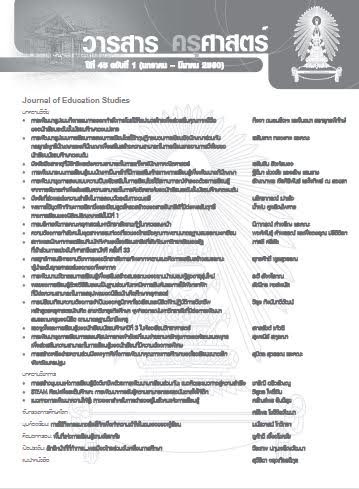แรงจูงใจและการเรียนรู้ของนักเรียนมัธยมศึกษาปีที่ 3 ในห้องเรียนวิทยาศาสตร์
Keywords:
แรงจูงใจ, การเรียนรู้วิทยาศาสตร์, วิธีการเสริมสร้างแรงจูงใจ, นักเรียนชั้นมัธยมศึกษาปีที่ 3, MOTIVATION, SCIENCE LEARNING, MOTIVATIONAL STRATEGIES, NINTH GRADE STUDENTSAbstract
งานวิจัยนี้มีวัตถุประสงค์ เพื่อศึกษาแรงจูงใจในการเรียนรู้และการเรียนรู้วิทยาศาสตร์ของนักเรียนชั้นมัธยมศึกษาปีที่ 3 และ ศึกษาวิธีการเสริมสร้างแรงจูงใจในการเรียนรู้วิทยาศาสตร์ของนักเรียนชั้นมัธยมศึกษา ปีที่ 3 ประชากรในการวิจัย คือ นักเรียนชั้นมัธยมศึกษาปีที่ 3 และครูวิทยาศาสตร์ ผู้เข้าร่วมการวิจัย คือ นักเรียนชั้นมัธยมศึกษาปีที่ 3 จำนวน 315 คน และครูวิทยาศาสตร์ จำนวน 12 คน จากโรงเรียนมัธยมศึกษาของรัฐบาล 12 โรงเรียน ครอบคลุม 4 ภาคของประเทศไทย เครื่องมือที่ใช้เก็บรวบรวมข้อมูล ประกอบด้วย 1) แบบสอบถามแรงจูงใจในการเรียนรู้และการเรียนรู้ สำหรับนักเรียนประเมินตนเอง 2) แบบสอบถามแรงจูงใจ การเรียนรู้ และวิธีการเสริมสร้างแรงจูงใจสำหรับครูเป็นผู้ประเมิน แล3) แบบสังเกตแรงจูงใจในการเรียนรู้ การเรียนรู้ และวิธีการเสริมสร้างการเรียนรู้ สำหรับผู้สังเกตการณ์ การสรุปข้อมูลแรงจูงใจและการเรียนรู้วิเคราะห์จากความสอดคล้องของข้อมูลโดยใช้การตรวจสอบแบบสามเส้าจาก 3 แหล่ง คือ นักเรียน ครูผู้สอน และผู้สังเกตการณ์ ส่วนข้อมูลวิธีการเสริมสร้างแรงจูงใจพิจารณาจากความสอดคล้องกันของข้อมูลครูผู้สอนและผู้สังเกตการณ์
ผลการวิจัยพบว่า 1) นักเรียนชั้นมัธยมศึกษาปีที่ 3 ส่วนใหญ่มีระดับแรงจูงใจในการเรียนรู้วิทยาศาสตร์อยู่ระหว่างระดับ ปานกลาง-สูง ถึง ระดับสูง และนักเรียนส่วนใหญ่มีแรงจูงใจในการเรียนรู้วิทยาศาสตร์จากภายใน 2) นักเรียนชั้นมัธยมศึกษาปีที่ 3 ส่วนใหญ่มีระดับการเรียนรู้อยู่ระหว่าง ระดับต่ำ-ปานกลาง 3) วิธีการเสริมสร้างแรงจูงใจในการเรียนรู้วิทยาศาสตร์ที่ครูส่วนใหญ่ใช้ คือ การกระตุ้นในเกิดการเรียนรู้ร่วมกันทั้งชั้นเรียน และการกระตุ้นแรงจูงใจของนักเรียนด้วยปัจจัยภายใน
The purposes of this research were to investigate ninth grade students’ learning motivation and science learning, and teachers’ motivational strategies to support students’ motivation. The research population consisted of ninth grade students and their teachers. The participants were 315 ninth grade students and 12 science teachers in 12 classrooms from public secondary school in 4 regions of Thailand. The research instruments consisted of a students’ self-report questionnaire, teachers’ self-report questionnaire, and an observation form for observers. The level of motivation and learning were collected from 315 students, 12 teachers and 2 observers, and were then analyzed by using triangulation. The consistency of motivational strategies collected from teachers and observers were examined.
The findings of the research can be summarized as follows: 1) Most of the ninth grade students’ learning motivation rated at a moderate-high and high level. The majority of students reported that they had internal motivation to learn science. Most students were rated at a relatively high level of motivation; 2) most students’ learning rated at low-moderate level; and 3) most teachers supported their students’ motivation by encouraging them to learn with the whole class and by creating internal interest and a positive atmosphere.




